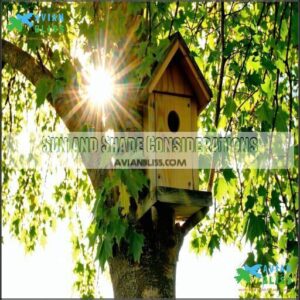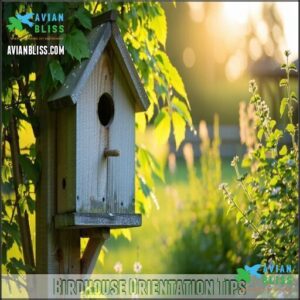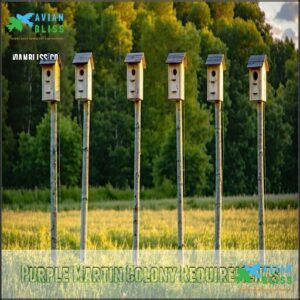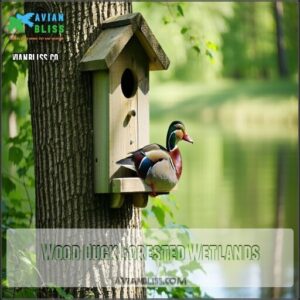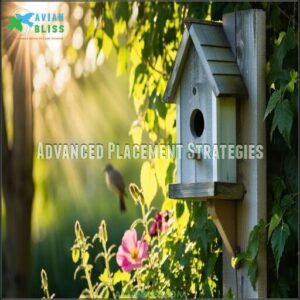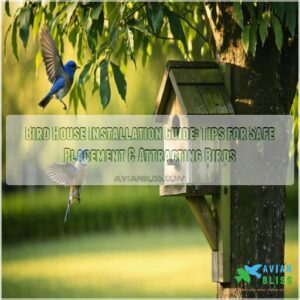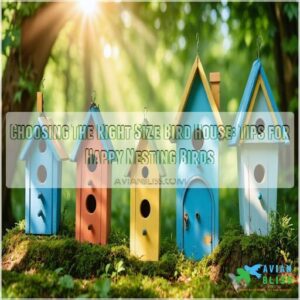This site is supported by our readers. We may earn a commission, at no cost to you, if you purchase through links.
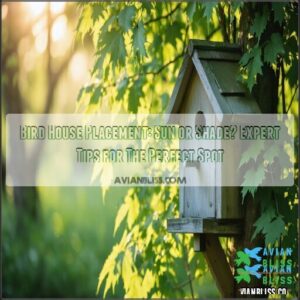
Place the birdhouse where it gets morning sun but stays shaded during hot afternoons. Birds appreciate the warmth for early activity, but too much direct sunlight can turn their home into an oven.
Find a spot under a tree or near shrubs to create a natural cooling effect. Make sure the entrance faces east or southeast to avoid harsh winds and afternoon sun beating straight in.
Also, keep it safe from predators by placing it 5–10 feet off the ground. Trust us—your feathered friends will thank you, and appreciate the healthy balance, the natural cooling effect, and the protection from harsh winds and predators.
Table Of Contents
- Key Takeaways
- Birdhouse Placement Basics
- Choosing Ideal Location
- Sun and Shade Considerations
- Birdhouse Orientation Tips
- Height and Predator Avoidance
- Species Specific Placement
- Advanced Placement Strategies
- Frequently Asked Questions (FAQs)
- Should a birdhouse be in sun or shade?
- Where not to put a bird house?
- How do urban locations affect birdhouse success?
- Can birdhouses be placed near water sources?
- Do birdhouses attract unintended species or pests?
- How does noise impact birdhouse effectiveness?
- Should birdhouses be moved seasonally for better results?
- Conclusion
Key Takeaways
- Place the birdhouse where it gets morning sun for warmth and shade in the afternoon to prevent overheating.
- Face the birdhouse east or southeast to shield it from strong winds and harsh afternoon sunlight.
- Keep it 5–10 feet off the ground to deter predators and ensure safety for nesting birds.
- Avoid dense vegetation and overcrowding; space birdhouses at least 25–30 feet apart for comfort and reduced conflicts.
Birdhouse Placement Basics
You’ll want to place your birdhouse where it’s easy to observe and maintain without disturbing its residents.
Spacing birdhouses properly, usually 25 feet apart, helps birds feel safe and reduces overcrowding.
Accessibility for Bird Watchers
Making your birdhouse accessible guarantees easy cleaning and safe monitoring while maximizing birdhouse observation.
Choose a birdhouse location that balances visibility and simplicity.
Here’s how to improve access:
- Use a position with clear viewing angles for nest observation.
- Mount at a height comfortable for maintenance.
- Avoid dense vegetation obstructing access.
- Place along paths you regularly walk for casual birdhouse visibility.
By following these steps, you can ensure your birdhouse is both safe and easily observable, making the most out of your birdwatching experience.
Birdhouse Spacing
Proper birdhouse spacing prevents territorial conflicts and promotes species diversity.
Birds are protective of their nesting spots, so aim to place birdhouses at least 25-30 feet apart.
For bluebirds, extend this spacing to 100 feet to reduce nesting competition.
Crowding can increase population density but disrupts harmony, and thoughtful birdhouse placement fosters balance, avoids overcrowding effects, and guarantees every bird has its safe, cozy spot, ensuring species diversity and promoting a balance.
Choosing Ideal Location
You’ll want to pick a spot that balances sunlight and shade, ensuring birds stay comfortable throughout the day.
Look for open areas with tall grass nearby, away from strong winds and harsh afternoon sun, where birds can find comfort.
Open Areas With Tall Grass
Birdhouse placement works best in open areas surrounded by tall grass.
This setup benefits predator visibility and attracts species like swallows and bluebirds, which thrive in exposed settings.
An open area size that’s large enough guarantees easy maintenance access.
Consider birdhouse sunlight needs and shade requirements, balancing morning warmth with some coverage to keep them comfortable.
Facing Away From Prevailing Winds
Placing your birdhouse with its entrance facing away from prevailing winds helps keep nests dry and offers better weather protection.
A well-chosen direction also enhances microclimate comfort for nesting birds.
Here are tips for minimizing wind exposure:
- Identify your regional climate’s wind patterns.
- Face east or northeast when possible.
- Shield from strong rains.
- Avoid direct gusts.
- Choose sheltered spots to reduce wind exposure.
By following these guidelines, you can create a more protected environment for the birds, keeping their nests dry and enhancing their overall comfort.
Shading From Sun
Keeping the birdhouse shaded is about balance. A bit of afternoon shade prevents overheating while maintaining a cozy microclimate for nestlings.
Avoid placing it in dense shade, which can trap dampness. For proper temperature regulation, morning sunlight helps with warmth, but too much sun exposure risks discomfort.
Understanding birdhouse shade requirements can make a huge difference in nestling comfort and safety. Consider using durable mounting poles for ideal placement.
Sun and Shade Considerations
Placing a birdhouse where it gets morning sun and afternoon shade helps regulate temperature, keeping the nest comfortable for its occupants.
Avoid spots with full-day direct sunlight, as excessive heat can harm young birds and make the house uninviting.
Importance of Morning Sun
Morning sun creates a cozy microclimate, warming the birdhouse and gently nudging nestlings awake.
Eastern exposure balances birdhouse sunlight needs without overheating, making mornings perfect for foraging benefits.
Birds start early, seizing their day with energy, and this warmth enhances temperature regulation while meeting birdhouse shade requirements.
A sunny morning keeps birds thriving yet avoids the afternoon heat’s challenges, offering ideal conditions for nestling warmth, and providing an environment where birds can thrive.
Afternoon Shade Benefits
Afternoon shade offers relief from heat, reducing birdhouse overheating and cooling nestlings during warmer hours.
It also helps prevent mold and insect buildup, keeping the home healthier.
Strategic birdhouse placement in partial shade guarantees extended occupancy as birds prefer comfortable temperatures.
Follow this birdhouse placement advice: balancing sun exposure with shade protects young birds while minimizing maintenance issues, ensuring a healthier environment.
Avoiding Direct Sun
Direct sun isn’t a bird’s best friend.
Prolonged birdhouse sun exposure leads to overheating, affecting nestling comfort.
For solid overheating prevention, aim for partial shading, especially in hot afternoons.
Temperature regulation matters—create a microclimate by balancing sun or shade.
Avoid midday sun damage by placing birdhouses where morning sun beams gently, and afternoon shade cools things off naturally, ensuring temperature regulation and a comfortable environment for nestling comfort.
Birdhouse Orientation Tips
Facing your birdhouse in the right direction can make all the difference for nesting birds.
An east or southeast orientation protects them from rain, offers warmth in the morning, and shields the nest from harsh afternoon sun.
East or Southeast Direction
An east-facing orientation, or slightly southeast, guarantees your birdhouse gets morning sunlight while avoiding harsh afternoon heat.
This balance helps regulate temperature, creating a cozy microclimate perfect for nesting.
Early sun exposure wakes birds, boosting foraging benefits.
Plus, the direction minimizes rain entry, enhancing rain protection, and proper birdhouse sun exposure promotes comfort and safety, making it an ideal choice for feathered friends.
Protection From Rain
Rain protection is a must for comfortable birdhouse placement.
A smart roof design with a 2-3 inch entrance overhang shields against downpours. Use weatherproof materials like cedar or redwood for lasting durability.
Add drainage holes to prevent water pooling inside.
Remember, wind direction matters—orient birdhouses away from prevailing gusts to keep nests dry and avoid unnecessary birdhouse weather protection repairs.
Avoiding Harsh Afternoon Sun
Shielding nests from harsh weather doesn’t stop at rain; keeping out intense afternoon sun is equally important.
For overheating prevention and nestling comfort, avoid western exposure. Too much heat can harm young birds.
Proper birdhouse materials, paired with strategic placement, guarantee temperature regulation. Positioning in partial afternoon shade balances warmth and protection, offering ideal birdhouse sun protection.
Consider using durable natural materials like cedar for construction, ensuring a safe and protected environment.
Height and Predator Avoidance
Placing your birdhouse at the right height isn’t just a numbers game—it’s key to keeping predators at bay.
Aim for at least 5 feet off the ground, and consider adding a sturdy predator guard to guarantee your feathered friends stay safe.
Optimal Height Above Ground
Finding the sweet spot for birdhouse height above ground isn’t just guesswork; it’s about combining safety and practicality.
Birds prefer their homes elevated for predator avoidance and comfort.
Aim for:
- Wrens/Chickadees: 5-10 feet.
- Bluebirds: 5-6 feet.
- Swallows: 8-12 feet.
- Larger species: 8-15 feet.
This balance mimics habitat, benefits species variation, and simplifies maintenance access.
Detering Ground Predators
Positioning your birdhouse correctly helps keep predators at bay.
Use pole mounting to elevate it at least 5 feet, avoiding dense bushes or trees where predators like squirrels and snakes hide.
Height advantage and clear surroundings are key for birdhouse predator deterrence.
Consider using effective predator guards for added protection.
Choose a location with open space, ensuring no climbing shortcuts are nearby—your feathered friends will feel much safer in an environment with a height advantage.
Using Predator Guards
Adding predator guards is a smart way to protect birdhouses.
Cone-shaped baffles or sheet-metal shields are popular guard types for predator deterrence, including squirrel and snake prevention.
Install predator guards below the birdhouse using sturdy materials like metal for durability.
Many options exist for birdhouse predator protection, and regular maintenance guarantees effectiveness.
Test placements in sun or shade for added safety, and keep predators from accessing nests.
Species Specific Placement
You’ll want to match the birdhouse location to the needs of the species you’re attracting, as different birds prefer specific habitats.
Whether it’s open fields for bluebirds, wetlands for wood ducks, or higher perches for purple martins, proper placement guarantees their comfort and safety.
Bluebird Habitat Preferences
To attract bluebirds, focus on open fields with short grass and scattered trees.
Place birdhouses 4-6 feet high with clear flight paths and an east-facing entrance.
Here’s your checklist:
- Choose rural areas with minimal traffic.
- Space birdhouses 100 feet apart for peace.
- Avoid placing near bird feeders.
- Face entrances away from strong winds.
Purple Martin Colony Requirements
Purple Martins thrive in colonies, so spacious housing like gourds or multi-roomed birdhouses works best.
Use durable, weather-resistant materials and mount houses 15–20 feet high near open areas with water.
Place each house at least 60 feet apart for proper gourd spacing. Face entrances away from winds, guarantee predator control, and provide clear flyways to attract this social bird species, ensuring a suitable environment for social bird.
Wood Duck Forested Wetlands
Wood ducks thrive near wetlands. Choosing the right birdhouse placement is essential for their nesting ecology and duckling survival.
Place boxes 15-20 feet high near water, facing away from winds. Include four inches of wood shavings inside.
Omnivorous feeding habits influence their habitat choices. Avoid predator-heavy zones.
Here’s how to help:
- Mount on trees or poles by water.
- Confirm entrance faces calm terrain.
- Prioritize habitat restoration efforts.
Advanced Placement Strategies
You’ll need to think beyond basic placement to create the perfect environment for your birdhouse.
By balancing sun and shade, avoiding dense vegetation, and respecting territorial space, you can attract birds while keeping them safe and comfortable.
Balancing Sun and Shade
Balancing sun and shade is key for ideal birdhouse placement.
Morning sun warms the birdhouse and helps regulate temperature, while afternoon shade prevents overheating.
Keep ventilation needs in mind to reduce humidity and create a steady microclimate.
Here’s a quick guide:
| Factor | Sunlight Needed | Shade Importance |
|---|---|---|
| Temperature Regulation | Morning exposure boosts warmth | Afternoon shade prevents heat |
| Ventilation Needs | Prevents dampness inside | Encourages airflow |
| Seasonal Adjustments | Critical for spring nests | Avoids summer heat stress |
Avoiding Dense Vegetation
Dense vegetation may seem ideal, but it poses risks like Predator Concealment and limited birdhouse visibility.
Overhead cover blocks sunlight, leading to Dampness Prevention issues, poor Ventilation Concerns, and potential insect infestation.
For effective birdhouse placement, balance sun or shade by choosing open spots with sparse plants, ensuring warmth, dryness, and protection.
Birds need airflow—not a gloomy forest retreat with Dampness Prevention issues.
Respecting Territorial Needs
When thinking about birdhouse placement, pay attention to spacing requirements to avoid territorial disputes.
Many bird species have nesting distance preferences—bluebirds need 100 feet apart, while colony nesting birds like purple martins thrive closer together.
Ensuring balanced populations reduces territorial conflicts.
Understanding territorial defense strategies can further optimize birdhouse placement.
Whether in sun or shade, respecting these preferences maintains harmony and boosts nesting success.
Birds appreciate a no-drama neighborhood too!
Frequently Asked Questions (FAQs)
Should a birdhouse be in sun or shade?
Place the birdhouse where it gets morning sun and afternoon shade.
This keeps the nest warm for early feeding and cool later.
Avoid full sun or dense shade to maintain balance and comfort, this is crucial for the balance.
Where not to put a bird house?
Over 70% of predators target ground-level nests, so avoid placing birdhouses low to the ground, in dense vegetation, or near feeders.
Stay clear of busy areas like playgrounds, patios, and places where pets roam.
How do urban locations affect birdhouse success?
Urban areas can make birdhouse success tricky due to noise, limited greenery, and high human activity.
Choose quieter spots with nearby vegetation for cover, and avoid high-traffic places like patios or near feeders to maximize results.
Can birdhouses be placed near water sources?
A birdhouse near water is like beachfront property for birds—tempting and practical.
Birds love nearby drinking or bathing spots, but make certain it’s not too close to avoid predators like snakes or raccoons lurking nearby.
Do birdhouses attract unintended species or pests?
Yes, birdhouses can attract unintended guests like squirrels, starlings, or wasps.
To prevent this, use predator guards, make certain proper hole sizes, and clean regularly.
Nature doesn’t send RSVPs, so you’ve got to stay prepared!
How does noise impact birdhouse effectiveness?
Loud noises, like steady traffic or construction, can stress birds, making nesting less likely.
They’ll choose quieter spots for safety.
Think of it like you trying to sleep next to a blaring concert speaker!
Should birdhouses be moved seasonally for better results?
Think of birdhouses like real estate.
While you don’t need to move them seasonally, ensuring they’re in an east-facing spot with morning sun and afternoon shade improves comfort and keeps bird tenants happy year-round.
Conclusion
Imagine a birdhouse tucked under a tree, catching the gentle morning sun while staying cool in the afternoon shade.
Striking this balance is key for effective bird house placement—sun or shade both play critical roles.
Point the entrance east or southeast to shield birds from harsh winds and intense afternoon heat.
Keep it 5–10 feet high to deter predators, and by placing the birdhouse wisely, you’ll give your feathered friends a safe, comfortable, and inviting home.



